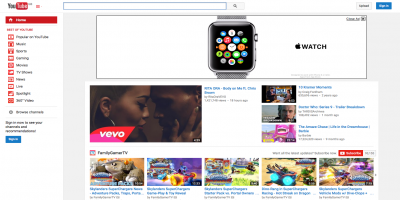-
Tips for becoming a good boxer - November 6, 2020
-
7 expert tips for making your hens night a memorable one - November 6, 2020
-
5 reasons to host your Christmas party on a cruise boat - November 6, 2020
-
What to do when you’re charged with a crime - November 6, 2020
-
Should you get one or multiple dogs? Here’s all you need to know - November 3, 2020
-
A Guide: How to Build Your Very Own Magic Mirror - February 14, 2019
-
Our Top Inspirational Baseball Stars - November 24, 2018
-
Five Tech Tools That Will Help You Turn Your Blog into a Business - November 24, 2018
-
How to Indulge on Vacation without Expanding Your Waist - November 9, 2018
-
5 Strategies for Businesses to Appeal to Today’s Increasingly Mobile-Crazed Customers - November 9, 2018
ASA publishes new guidelines for vloggers
Newsround highlighted a group of UK vloggers who were paid to say good things about Oreo biscuits, but none of the videos were labelled as adverts.
Advertisement
CAP’s guidance is straightforward: if you are paid to promote something and the advertiser controls the message then the content is an ad. All ads must be “obviously identifiable” as such.
The new guidance comes in response to calls for greater clarity from vloggers themselves about when content in their videos is classed as advertising and follows an Advertising Standards Authority (ASA) ruling last year in which several sponsored vlogs (featuring brands such as Oreo and P&G) were found to be misleading because they did not make clear before consumers engaged with the videos that they were ads.
CAP also stressed that, as requested by vloggers – advertising agencies and brands also have an obligation to be transparent when proposing any potential commercial partnerships.
“Although they might indicate to some viewers that Oreo had been involved in the process, they did not clearly indicate that there was a commercial relationship between the advertiser and the vloggers (i.e. that the advertiser had paid for and had editorial control over the videos)”.
Shahriar Coupal director of CAP said that wherever ads appear the public should be confident they can trust what an advertiser says.
The new guidelines cover eight scenarios – from “advertorial vlogs” and product placement, to commercial breaks within vlogs and brand sponsorship – however, do not cover or prohibit vloggers from entering into commercial relationships, nor influence editorial opinion.
“A lot of YouTube creators are much more savvy and aware of branded content rules than they were a few years ago”, he explained.
“If YouTubers are doing it wrong it’s because they don’t know better”.
Advertisement
They are increasingly viewed as role models by teenagers, according to Your Life, a government-backed campaign encouraging young people to choose maths and physics at A-level.





























